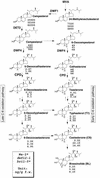Arabidopsis brassinosteroid-insensitive dwarf12 mutants are semidominant and defective in a glycogen synthase kinase 3beta-like kinase
- PMID: 12428015
- PMCID: PMC166669
- DOI: 10.1104/pp.010496
Arabidopsis brassinosteroid-insensitive dwarf12 mutants are semidominant and defective in a glycogen synthase kinase 3beta-like kinase
Abstract
Mutants defective in the biosynthesis or signaling of brassinosteroids (BRs), plant steroid hormones, display dwarfism. Loss-of-function mutants for the gene encoding the plasma membrane-located BR receptor BRI1 are resistant to exogenous application of BRs, and characterization of this protein has contributed significantly to the understanding of BR signaling. We have isolated two new BR-insensitive mutants (dwarf12-1D and dwf12-2D) after screening Arabidopsis ethyl methanesulfonate mutant populations. dwf12 mutants displayed the characteristic morphology of previously reported BR dwarfs including short stature, short round leaves, infertility, and abnormal de-etiolation. In addition, dwf12 mutants exhibited several unique phenotypes, including severe downward curling of the leaves. Genetic analysis indicates that the two mutations are semidominant in that heterozygous plants show a semidwarf phenotype whose height is intermediate between wild-type and homozygous mutant plants. Unlike BR biosynthetic mutants, dwf12 plants were not rescued by high doses of exogenously applied BRs. Like bri1 mutants, dwf12 plants accumulated castasterone and brassinolide, 43- and 15-fold higher, respectively, providing further evidence that DWF12 is a component of the BR signaling pathway that includes BRI1. Map-based cloning of the DWF12 gene revealed that DWF12 belongs to a member of the glycogen synthase kinase 3beta family. Unlike human glycogen synthase kinase 3beta, DWF12 lacks the conserved serine-9 residue in the auto-inhibitory N terminus. In addition, dwf12-1D and dwf12-2D encode changes in consecutive glutamate residues in a highly conserved TREE domain. Together with previous reports that both bin2 and ucu1 mutants contain mutations in this TREE domain, this provides evidence that the TREE domain is of critical importance for proper function of DWF12/BIN2/UCU1 in BR signal transduction pathways.
Figures





References
-
- Bell CJ, Ecker JR. Assignment of 30 microsatellite loci to the linkage map of Arabidopsis. Genomics. 1994;19:137–144. - PubMed
-
- Bianchi MW, Guivarc'h D, Thomas M, Woodgett JR, Kreis M. Arabidopsis homologs of the shaggy and GSK-3 protein kinases: molecular cloning and functional expression in Escherichia coli. Mol Gen Genet. 1994;242:337–345. - PubMed
-
- Bienz M, Clevers H. Linking colorectal cancer to Wnt signaling. Cell. 2000;103:311–320. - PubMed
Publication types
MeSH terms
Substances
Associated data
- Actions
LinkOut - more resources
Full Text Sources
Other Literature Sources
Molecular Biology Databases
Miscellaneous

